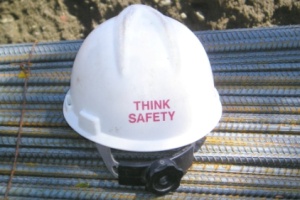 On Tuesday afternoon, October 23, National Safety Congress and Expo attendees had the chance to see and hear Colin Duncan, CEO of BST, deliver a keynote address. Colin is responsible for driving BST’s global strategy, corporate vision, and the innovation of new methodologies and approaches to deliver sustainable safety improvements to clients the world over.
On Tuesday afternoon, October 23, National Safety Congress and Expo attendees had the chance to see and hear Colin Duncan, CEO of BST, deliver a keynote address. Colin is responsible for driving BST’s global strategy, corporate vision, and the innovation of new methodologies and approaches to deliver sustainable safety improvements to clients the world over.
Colinis an emerging thought leader in occupational safety and health. His new-era thinking is on display in his latest book, “The Zero Index: A Path to Sustainable Safety Excellence,”available on the BST website. This post on the BST site offers you insight into the thought leadership of Colin Duncan.
In 1988, an explosion and fire aboard the North Sea rig Piper Alpha left 167 men dead, nearly £2 billion (US $3.4 billion) in damage and lost production, and a local community and its families devastated by the loss. At the time, the CEO of Occidental Petroleum infamously remarked, “We have done all we can to prevent catastrophic failures like this one.”
In 2010, history seemed to repeat itself on the Deepwater Horizon platform. This time the loss of control of a wellhead led to an explosion and fire that killed 11 workers. What followed was a public relations nightmare as the media played out a narrative of technical and management failure against a backdrop of environmental disaster.
The persistent question was, Why?
Haven’t we advanced safety engineering and practice over these past 20 years? Haven’t we learned from the past? Like his predecessor before him, BP’s then CEO was at a loss to explain it, saying simply, “Sometimes you step off the curb and get hit by a bus.”
What his statement suggests is that despite an evolution in engineering and technical ability that has allowed industry to realize incredible achievement, our understanding of risk, specifically its identification and mitigation, has lagged woefully behind.
Now as then, the apparent resignation, and sometimes outright fatalism, surrounding safety in modern industry is notably incongruous with the organizational and technological advancement of the past 25 years.
Few leaders today would consider explaining poor production, low quality, or operating losses as “bad luck.” Yet we still hear some accept safety failures as just that.
We know from our work with organizations around the world that senior leaders care deeply about the wellbeing of their people. We know that given the right information, they are capable of moving their organizations forward in remarkable ways. Yet, consistent and coherent safety performance continues to elude many organizations.
The truth is that safety performance is not a function of luck, chance, or circumstance. Consider the fact that over the last 10 years we have seen non-fatal injury rates drop by 25% or 50% or more in many regions. There are notable success stories, such as the South African mining industry’s significant reduction in fatalities over the last five years. Anecdotally, from our work with organizations in the field, we have seen many organizations go months, if not years, without a lost-time or life-altering injury. Many organizations make substantial improvements in injury rates through a rigorous and disciplined approach to understanding risk and taking action on those risks.
The question is not whether safety excellence is possible, but what makes it possible.
SAFETY AS STRATEGY
Achieving a truly zero-harm organization starts with taking a huge step back from our existing ideas and assumptions. This book introduces a state of functioning that we call Zero Index performance: the sustained practice of mitigating exposure to anyone who interacts with an organization and its activities and products—not just your employees but also your customers, vendors, visitors, and community.
Safety performance can be roughly grouped into low, average, and high levels that denote the sophistication and fluency with which the organization applies key disciplines. To create the model we call the Zero Index, we’ve created a dynamic scale that starts at the low end of safety performance with Avoidance-driven, continues in the middle with Compliance-driven, and ends with Values-driven—the state of zero harm.
At the Avoidance level of safety performance, safety is a burdensome necessity.
At the Compliance level, it is a priority, an important goal. But at the Values level, safety is not just a value for the organization—it is who we are. Zero Index organizations are distinguished by their ability to take a big picture view of safety performance. In Zero Index, safety is not a program but an integral business function that is influenced by—and, in turn, influences— operational execution.
Zero Index performance is characteristically:
· Comprehensive: Safety activities are guided by a detailed, granular strategy developed from a comprehensive understanding of the gap between where the organization is and where it desires to be. The organization acts on a holistic picture of safety performance; the goal is bigger than any single area or outcome.
· Anticipatory: Safety performance is driven by a sophisticated set of metrics that detect changes in exposure before such changes create events.
· Externally and internally focused: The organization adapts to changes that influence exposure within and outside the organization.
· Integrated:Safety activities are coordinated across functions; they complement other business systems and processes and show a high degree of skill and sophistication. The organization executes safety in concert with other business goals; the line between “work” and “safety” has disappeared, because real work is expected to be safe work, and the activities that make work safe are a regular part of the work, not something accomplished separately by a separate team.
· Risk based versus outcome based: Exposure is the measure of progress (Is exposure going down? Do we know where the exposures are?) and the trigger for change (we act when exposure changes, not just when exposure leads to actual injury).
In a Zero Index organization, safety performance is no longer treated as something “other”; the goals, activities, planning, and results are a natural part of the organization’s overall performance, integrated with day-to-day business functions and decisions. Safety is not thought to be in opposition to business goals, the way it is sometimes looked on as an important (but separate) consideration during, say, the design of a new piece of equipment.
Clearly, achieving this level of performance is not easy. No organization starts out as a Zero Index organization. In safety, as with all human endeavors, excellence is achieved in stages.
One could argue that the fact that we’re talking about a particular aspect of performance—safety—is incidental: these principles can be applied more broadly. Safety is an ideal place to begin organizational change, because it is one of the most fundamental drives of human beings. Safety is bedrock. If you can do safety well, you can do other things well.
Our ultimate aim is to help you as a CEO, COO, executive, plant manager, or safety leader understand the gap between where you are and where you want to be—so you can manage toward a future goal while avoiding the trap of programs and fads.



